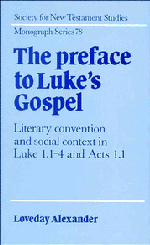Book contents
- Frontmatter
- Contents
- Acknowledgements
- Abbreviations
- 1 The Lucan preface: questions and assumptions
- 2 On the beginnings of books
- 3 Historical prefaces
- 4 Scientific prefaces: origins and development
- 5 Scientific prefaces: structure, content and style
- 6 Luke's preface
- 7 Prefaces in hellenistic Jewish literature
- 8 The social matrix of Luke's preface
- 9 The appropriate form of words for the occasion
- Appendix A Structural analysis of Luke 1.1–4 and selected scientific prefaces
- Appendix B Bibliographical notes on scientific prefaces
- Select bibliography
- Index of scientific authors
- Index of ancient authors and names
- Index of modern authors
- Index of subjects
8 - The social matrix of Luke's preface
Published online by Cambridge University Press: 15 October 2009
- Frontmatter
- Contents
- Acknowledgements
- Abbreviations
- 1 The Lucan preface: questions and assumptions
- 2 On the beginnings of books
- 3 Historical prefaces
- 4 Scientific prefaces: origins and development
- 5 Scientific prefaces: structure, content and style
- 6 Luke's preface
- 7 Prefaces in hellenistic Jewish literature
- 8 The social matrix of Luke's preface
- 9 The appropriate form of words for the occasion
- Appendix A Structural analysis of Luke 1.1–4 and selected scientific prefaces
- Appendix B Bibliographical notes on scientific prefaces
- Select bibliography
- Index of scientific authors
- Index of ancient authors and names
- Index of modern authors
- Index of subjects
Summary
Isolated phenomenon or historical pattern?
In an address to the British Academy in 1954, the great papyrologist C. H. Roberts made the observation that the early Christian groups were among the first to use the codex regularly in preference to the roll for substantial texts. Roberts' observation was confirmed by E. G. Turner in 1968 (E. G. Turner, 1968, pp. 10ff.), and is documented more fully in Roberts and Skeat, The Birth of the Codex (1987). For the historian of the early church, this observation poses a problem. Is it simply an isolated phenomenon or does it form part of a pattern? And how many such observations do we need before we can reasonably claim to have discovered a historical pattern?
We might compare the position of the historian here with that of an archaeologist faced with a collection of broken potsherds. Reconstruction of a whole pot would be nice, but the archaeologist does not even know at the outset if the fragments in the pile are all part of one pot: they might be the remnants of two or three pots, or be a completely random collection with no links whatever. Thus the archaeologist is not in the position of the jigsaw-doer, who is able to start with the presupposition that all the pieces in the box will make up a single picture.
- Type
- Chapter
- Information
- The Preface to Luke's Gospel , pp. 168 - 186Publisher: Cambridge University PressPrint publication year: 1993



